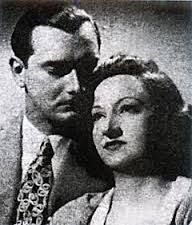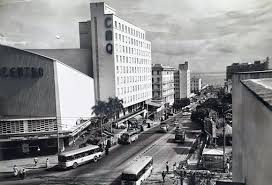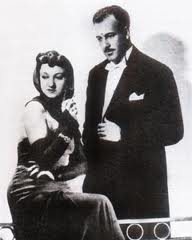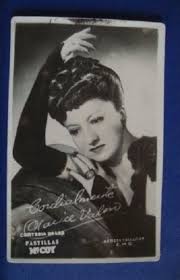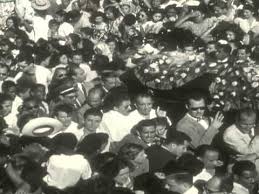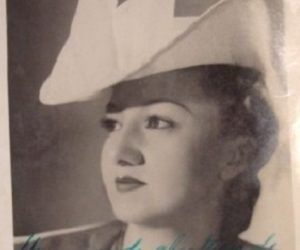 VIDA ARTISTICA Y MUERTE DE “LA GRAN DAMA DE LA RADIO CUBANA”, MARIA VALERO.
VIDA ARTISTICA Y MUERTE DE “LA GRAN DAMA DE LA RADIO CUBANA”, MARIA VALERO.
Le llamaban la ‘Gran Dama de la Radio Cubana’; era la madrugada del 26 de noviembre de 1948, cuando en la Avenida del Puerto, en la Habana, frente al restaurante El Templete, Maria Valero fue atropellada y arrastrada por un automóvil que, zigzagueante y a exceso de velocidad, conducía un borracho.
Desde su papel en ‘El collar de lágrimas’, de Pepito Sánchez Arcilla, que con sus más de 900 capítulos es la radionovela más larga en toda la historia del género, la actriz española María Valero se había convertido en la figura femenina más popular de la radio. Su arte y su voz maravillosa eran la admiración de los oyentes que seguían, devotos, sus interpretaciones.
CARRERA DE ACTRIZ.
Al comienzo fueron solo pequeños papeles, más bien bocadillos, y honorarios bajísimos. Pasa por Radiodifusión O’Shea y escribe pequeños textos que lee ella misma en Radio Lavín. Se abre paso en el teatro. Con la compañía de Nicolás Rodríguez, español exiliado como ella, se hace aplaudir en los teatros Apolo, América y Principal de la Comedia. «Pero Nicolás parte hacia México —dice la Bracero— y María sube a las estrellas. Su Doña Inés, en Don Juan Tenorio, de Zorrilla, fue, se dice, sencillamente insuperable. Logra entrar en el cotizado cuadro dramático de la firma jabonera Sabatés, subsidiaria de Procter and Gamble, empresa norteamericana que comenzaba a apoderarse de los horarios estelares en la emisora más importante que era todavía la RHC Cadena Azul.
Había hecho teatro en su patria y en La Habana el éxito le llegó más temprano que tarde. Casi enseguida pasó a formar parte, como artista exclusiva, del cotizado cuadro dramático de la firma jabonera Sabatés. Asida del brazo del galán de moda, Ernesto Galindo, formó la pareja romántica que hacía suspirar a jóvenes y mayores. Galindo y María serían los protagonistas de Doña Bárbara, la novela de Rómulo Gallegos que, en versión de Caridad Bravo Adams y con la dirección de Luis Manuel Martínez Casado, dos glorias de la radio nacional, se transmitió en el espacio La Novela del Aire, de RHC Cadena Azul.
LA NOVELA DEL AIRE.
Pero CMQ, que ya había iniciado su guerra a muerte contra la RHC, quería a María Valero en sus predios como artista exclusiva y le ofreció un salario de 600 pesos mensuales, suma no alcanzada por actriz alguna en Cuba, y totalmente desconocida hasta entonces en el medio radial. María aceptó la propuesta y se desbarató así la pareja que formó con Ernesto Galindo. A rey muerto, rey puesto; sin embargo, otra pareja artística surgirá en CMQ: la de María Valero y el primer actor Carlos Badías. Juntos actuarían en El precio de una vida, de Félix B. Caignet, y en el momento del accidente asumían, como Isabel Cristina y Albertico Limonta, los protagónicos de El derecho de nacer, la más célebre y recordada de todas las obras del famoso radionovelista santiaguero.
«Allí depositan la confianza y los recursos para crear una novela en el horario nocturno de las ocho y media de lunes a viernes. En ese escenario se inicia la novela diaria de continuidad, que después es seguida no solo en Cuba, también en el resto de América Latina», escribe Josefa Bracero en su libro. Para hacerla posible se escoge lo mejor. La escritora y el director son dos firmas de probada eficacia. El protagonista, el galán de moda, y la voz femenina, nueva e impactante, la pone María Valero. Luego, en CMQ, ‘El derecho de nacer’ la convertirá en toda una leyenda.
Y LLEGO EL FINAL..
Corría noviembre de 1948 y un cometa se hacía visible desde La Habana y su visión era imponente e insuperable si se le observaba desde la Avenida del Puerto, a las cinco de la mañana. María Valero con un grupo de amigos y compañeros, entre los que figuraba el primer actor Eduardo Egea, quiso vivir la experiencia. Diría entonces, en su columna del periódico Información, aquel cronista notable que fue Luis Amado Blanco: «Iba a mirar una estrella, una estrella errante, de esas que pasan sin dejar más rastro que su cola de luces esplendentes. Iba a mirar tan solo eso, un rastro de Dios por la alta bóveda. Y se quedó ya para siempre mirándola, destrozada por una brutal coincidencia, rotas su voz y su mirada, donde dormían tantos lejanos y ajenos infortunios».
El periodista Germinal Barral (Don Galaor), de quien se comenta que mantuvo una relación amorosa con la actriz, pero que no la acompañaba en su noche fatal, dice que el cantante Avelino Rangel llevaba del brazo a María y a Emilia Aragón, su pareja en el dúo Emilia y De Flores. Cuando se disponía a cruzar la Avenida, entonces en reparación, se percató del auto que se acercaba a ellos a gran velocidad. Detuvo la marcha sin imaginar la embestida que sufrirían. Emilia fue golpeada por el guardafango derecho y María Valero y Rangel fueron lanzados hacia atrás. La ropa de la actriz se enredó en la defensa trasera y el auto, en su loca carrera, la arrastró 12 metros. Murió instantáneamente.
El cadáver fue expuesto en la funeraria Caballero, en lo que después sería la Rampa habanera. Allí los fotógrafos captaron la última imagen de María. La mantilla negra que había traído de España le cubría la cabeza y parte del rostro maltratado por el accidente. Tanta era la gente que quería despedirse de su ídolo que para entrar a la casa mortuoria no quedó más remedio que formar una fila que arrancaba en Malecón y subía por 23, y otra desde la calle 27 hasta M. Una multitud enorme, que se dio cita de manera espontánea, la acompañó a pie hasta la necrópolis de Colón.
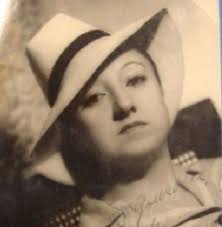 ARTISTIC LIFE AND DEATH OF “THE GREAT LADY OF THE CUBAN RADIO”, MARIA VALERO.
ARTISTIC LIFE AND DEATH OF “THE GREAT LADY OF THE CUBAN RADIO”, MARIA VALERO.
They called her the ‘Great Lady of the Cuban Radio’; it was the early morning of November 26, 1948, when on the Avenida del Puerto, en la Havana, opposite the restaurant El Templete, Maria Valero was hit and dragged by a car that, zigzagging and excess of speed, drove a drunk man.
From his role in ‘El collar de lágrimas’, by Pepito Sánchez Arcilla, which with its more than 900 episodes is the longest radio drama in the history of the genre, the Spanish actress María Valero had become the most popular female figure in Radio. His art and his wonderful voice were the admiration of the listeners who followed, devotees, their interpretations.
ACTRESS CAREER
In the beginning, they were only small papers, rather sandwiches, and very low fees. She goes through O’Shea Broadcasting and writes small texts that she reads on Radio Lavín. He makes his way in the theater. With the company of Nicolás Rodríguez, a Spanish exile like her, he is applauded at the Apolo, América and Principal de la Comedia theaters. “But Nicolas leaves for Mexico,” says Bracero, “and Maria goes up to the stars. His Doña Inés, in Don Juan Tenorio, of Zorrilla, was, it is said, simply insurmountable. It manages to enter the quoted dramatic picture of the signature soap store Sabatés, a subsidiary of Procter and Gamble, a North American company that began to take over the star schedules in the most important station that was still the RHC Cadena Azul.
He had done theater in his homeland and in Havana, the success came sooner rather than later. Almost immediately he became part, as an exclusive artist, of the quoted dramatic painting of the soap factory Sabatés. Holding the arm of the fashionable heartthrob, Ernesto Galindo, formed the romantic couple that made both young and old sigh. Galindo and María would be the protagonists of Doña Bárbara, the novel by Rómulo Gallegos that, in the version of Caridad Bravo Adams and with the direction of Luis Manuel Martínez Casado, two glories of the national radio, was broadcast in the space La Novela del Aire, of RHC Blue Chain.
THE NOVEL OF THE AIR.
But CMQ, which had already begun its war to the death against the RHC, wanted María Valero on her property as an exclusive artist and offered her a salary of 600 pesos a month, a sum not reached by any actress in Cuba, and totally unknown until then. the radial medium. Maria accepted the proposal and the couple she formed with Ernesto Galindo got upset. A dead king, the king put; however, another artistic couple will emerge in CMQ: María Valero and the first actor Carlos Badías. Together they would act in The Price of a Life, by Felix B. Caignet, and at the time of the accident they assumed, like Isabel Cristina and Albertico Limonta, the protagonists of El derecho de nacer, the most famous and remembered of all the works of the famous radio-opener santiaguero.
“There they place the trust and the resources to create a novel in the evening hours of eight-thirty from Monday to Friday. In this scenario the daily novel of continuity begins, which is then followed not only in Cuba but also in the rest of Latin America, “writes Josefa Bracero in her book. To make it possible, the best is chosen. The writer and the director are two proven firms. The protagonist, the fashionable gallant, and the feminine, new and impressive voice, put it, Maria Valero. Then, in CMQ, ‘The right to be born’ will turn it into a legend.
AND I ARRIVE THE FINAL…
It was November of 1948 and a comet was visible from Havana and its vision was imposing and insurmountable if it was observed from the Avenida del Puerto, at five o’clock in the morning. María Valero with a group of friends and colleagues, including the first actor Eduardo Egea, wanted to live the experience. I would say then, in his column of the newspaper Información, that notable chronicler who was Luis Amado Blanco: “He was going to look at a star, a wandering star, one of those that pass without leaving any trace but its splendid tail of lights. I was going to look at just that, a trace of God by the high vault. And he stayed forever looking at her, shattered by a brutal coincidence, his voice, and his eyes broken, where so many distant and unfortunate misfortunes slept “.
The journalist Germinal Barral (Don Galaor), who is said to have had a love affair with the actress, but who did not accompany her on his fatal night, says that the singer Avelino Rangel had María and Emilia Aragón, her partner in the duo Emilia and De Flores. When he was about to cross the Avenue, then in repair, he noticed the car approaching them at great speed. He stopped the march without imagining the onslaught they would suffer. Emilia was hit by the right fender and Maria Valero and Rangel were thrown back. The actress’s clothes became entangled in the rear fender and the car, in its mad run, dragged her 12 meters. He died instantly.
The corpse was exposed in the Caballero funeral home, in what would later be the Havana Rampa. There the photographers captured the last image of Maria. The black blanket he had brought from Spain covered his head and part of his face damaged by the accident. So many people wanted to say goodbye to their idol that to enter the funeral home there was no choice but to form a line that started at Malecón and went up by 23, and another from 27th Street to M. A huge crowd, which occurred spontaneously, he accompanied her on foot to the necropolis of Colón.
Agencies/ Ciro Bianchi/ Lecturas/ Excerpts/ Extractos/ Internet Photos/ Arnoldo Varona/ www.TheCubanHistory.com
THE CUBAN HISTORY, HOLLYWOOD.



 < ARTISTIC Life and Death of "The Great Lady of the Cuban Radio", María Valero.
< ARTISTIC Life and Death of "The Great Lady of the Cuban Radio", María Valero.